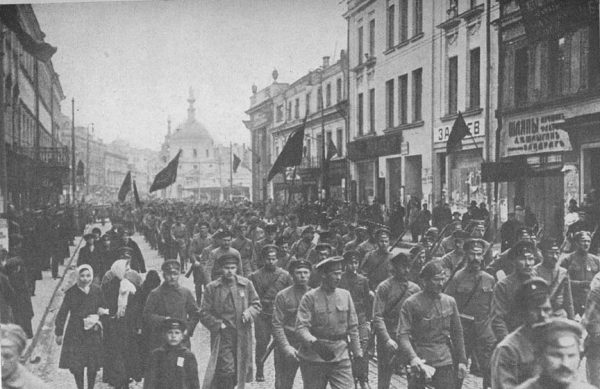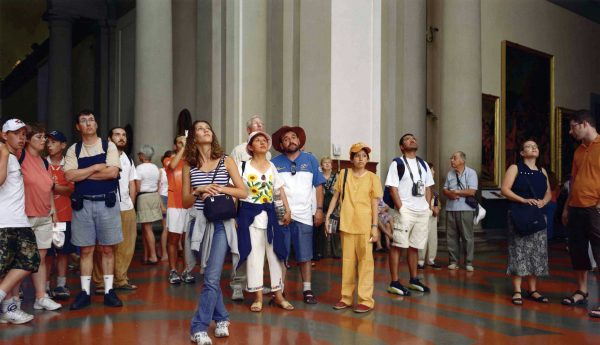‘Make Margaret Atwood fiction again!’ Despite encountering them repeatedly over the past few years, I still cannot entirely believe the sheer number of op-eds declaring that ‘we’ — a slippage which often seems really to mean ‘women in Saudi Arabia’ — are ‘living in The Handmaid’s Tale’. ‘How far are we from Gilead?’ ‘Could The Handmaid’s Tale happen today?’ asks the typical journalist, before providing the ‘chilling’ answer upfront, usually in the very headline: ‘For some women, it’s already reality’. It’s like a tic, or an exercise in wish-fulfilment.
The Handmaid’s Tale is certainly the world’s best-known sterility apocalypse. It is also one of the most successful novels of the last century, and now, together with its sequel The Testaments, of this century. When in October The Testaments was jointly awarded the 2019 Booker Prize with Bernadine Evaristo’s Girl, Woman, Other, a gracious Atwood told Evaristo that ‘It would have been quite embarrassing for me… if I had been alone here, so I’m very pleased that you’re here too.’ In fact, in light of the appropriative relation of Atwood’s novels to North American black women and their history, she has every reason to be embarrassed.
At this stage, The Handmaid’s Tale franchise is fully a fandom. Celebrities throw Handmaid parties; people hold their themed weddings in front of a set made to resemble the Gileadean ‘Wall’ that gender-traitors get hanged on; liberal-feminist websites delightedly issue po-faced injunctions to the world at large not to do any of this, and especially not — think of the handmaids you’re offending — to dress up as a ‘Sexy Handmaid’ at Halloween.
A personal encounter with Atwood’s breeder-dystopia is also currently the mainstream trope of political coming-to-consciousness testimonies in the era of Trump and #MeToo. For some reason, it is taken as given not only that the text is ‘feminist’, but that it is archetypally so. Despite its author’s (and the cast of the Hulu Handmaid’s Tale’s) repeated disavowals of feminist intent, the text’s synonymity with the Women’s March and the #Resistance has proven durable. Late in the year, the tech magazine Wired was proclaiming that ‘Handmaid’s Tale Garb’ is still ‘the Viral Protest Uniform of 2019’.
•
In September 2019, in honour of the publication of The Testaments, Helen Lewis — the Atlantic staff writer who has become notorious in Britain for her phobic fear-mongering about trans inclusion — wrote an article headlined ‘How far from Gilead is Britain in 2019?’ Her answer to this question, delivered with this genre of op-ed’s characteristic frisson of pleasure, was a firm not far, not far at all.
In the Acknowledgments section of The Testaments, Atwood unapologetically admits that the book is a work of fan service, produced to satisfy the mob’s desire to know: ‘How did Gilead fall?’ i.e., who freed the slaves? The answer being, surprise, not the slaves themselves, but the slaver Aunt Lydia. ‘The answers have changed as society itself has changed,’ Atwood continues. Thirty-five years since The Handmaid’s Tale was published, ‘possibilities have become actualities’. Say no more! She must have in mind Theresa May (or anybody and anything you wish). ‘Contemporary British society’, it is reasoned on the Penguin Random House blog, ‘calls women “loose” and “slags” for enjoying sex’. ‘Women are still divided into good and bad girls, based on a sexual double standard’. ‘Abortion providers still report harassment and intimidation outside their doors’. ‘Britain [is] like Gilead in a thousand subtle ways.’
Yet, as critics have long noted, whenever she speaks of her achievement with The Handmaid’s Tale, Atwood freely confesses that she borrowed horror stories about the treatment of women in Islamist-run countries – Saudi Arabia, Afghanistan or Iraq – and simply transposed them to the US. The writer John Dolan has argued that The Handmaid’s Tale is straightforwardly ‘fun horror-fiction for women who work in the American-style cubicle-world, precisely because it’s so utterly unrelated to the miseries and terrors of their own lives.’ While Dolan is too dismissive, I think this insight does help shed light on why Handmaid cosplay today, despite appearing antifascist and proclaiming ‘Blessed Be the Fight’, summons up not so much insurgency and revolt as an oddly quiescent (which is to say, anti-antifascist) stance vis-à-vis assaults on abortion access in the capitalist present. Innumerable anti-racist commentators have long recognised in the premise of Gilead what is essentially a de-raced slave narrative about forced surrogacy (or reproductive ownership) on the American plantation. The TV serialisation took this anti-historic fantasy of universalism further than the novel did, by imagining, to quote Hulu director Bruce Miller, that a society in which ‘fertility trumps all’ could (and would) be ‘diverse’ and ‘post-racist’. But instead of figuring out what solidarity means, some of us want to dress up and say ‘we are all reproductive slaves’, despite being white (i.e. with no direct ties to the butt-end of American reproductive slavery), financially secure, and mobile enough to feel no grave or immediate threat – even under Trump – to our own personal access to abortion.
•
Just a reminder of the basic – astonishingly reactionary, yet rarely questioned – premise of Gilead. As a result of ecological degeneration, secular immorality and STDs, drastic infertility has struck the United States, resulting in a scenario in which, as John Lennon and Yoko Ono (or Bette Midler) would put it, ‘woman is the n***er of the world’. A correlate of this, implied to be logical, is that women are now slaves. There is even, excruciatingly, an ‘Underground Femaleroad’ – an obvious riff on the Underground Railroad, the nineteenth-century network that helped enslaved people flee to Canada and to free states in the US.
Self-evidently, it is not the existence of borders and the carceral state per se, but rather the measures made ‘necessary’ internally by the dwindling human population-count, that constitute the core horror of Gilead. And because of the need to restore order – and birth-rates – a sadistic Puritan cult successfully stages a coup. Its paramilitaries control, as chattel, the few fertile people remaining (who are, by definition, women whose baby-making must be intensively husbanded). These ‘Handmaids’, former US citizens, are brutalised, indoctrinated, and punctually raped by the married property-owning couples of the gentry; Commanders and Wives. But all female humans, with the exception of the cattleprod-wielding comprador class of Aunts, are entirely disenfranchised and dispossessed of their property as well as banned from most activities – including writing and reading – on pain of torture, mutilation and death.
In both volumes, Atwood radically downplays the colonial and racial specificity of fascism and slavery, focusing instead on metaphysical and psychological aspects of the spread of what she calls ‘totalitarianism’. This is a task she seems to think is clarified, rather than muddied, by conducting a thought experiment around ‘pure’ uterine womanhood, women united in oppression. Both plots stage kinship dramas that are framed not as the violence that historically constituted whiteness and the ‘natural’ American family in the first place, but, rather, as a universal female agony: namely, the separation of a mother from her ‘biological’ daughters. At the end of The Testaments, these daughters – who have only just learned that their gestational parent was someone other than their respective mothers – are reunited with this ‘real mother’ in an embrace deterministically described as follows: ‘She smelled right.’ In Atwood’s dystopia, in other words, religiously extremist fascist slavers interfere systematically with some people’s blood-based kinship ties, but, happily, these blood-bonds ultimately prevail after the fall of the regime, and ‘biological’ parents and children get to be together ‘again’. The people in question are all white.
It is not just that adoptive mothering or ‘othermothering’ is downgraded in The Testaments (presumably, it doesn’t smell quite ‘right’). Queer kinships and polymaternalisms — the key to slave survival historically — are nowhere given due credit in Atwood’s imaginary. In Gilead, bloodlines are meticulously traced according to the white European settler pattern. But this is apparently not even part of what’s meant to be dystopian about it. It’s the surrogacy, which of course is here coerced (essentially at gunpoint), but which nevertheless is meant to stand as a metonym in and of itself for the ultimate form of dehumanisation. What is anathema in the Extended Universe of The Handmaid’s Tale is bearing a baby not destined to be your personal property. Because this, for Atwood – a veteran of the mid-‘80s antisurrogacy, anti-reprotech mobilisations – intrinsically means occupying a state of slave consciousness. The condition is borne, here, not by black bodies, but by racially unmarked ones, on the ‘pure’ basis of their sex. With its ghoulish, rape-centred vision of forced surrogacy, the Tale has consequently long been many white feminist progressives’ vision of an America turned living hell – an exercise requiring that one not experience America as all that hellish already.
Critical race scholars often remind contemporary young feminists of ‘eugenic feminism’ – the tradition of European and American women’s active efforts to sterilise and otherwise discourage the reproduction of nonwhiteness, deviance and disability – which forms part of our legacy. But the inconvenient truth we must face is this: the only plausible ‘we’ in the sentence ‘we are living in The Handmaid’s Tale’ belongs to nineteenth-century black women under chattel slavery – subjects who aren’t around any more and whose heirs and descendants have better things to do than defend against the theft of their history by Bruce Miller and Margaret Atwood.
Instead of forcing us to reckon with how, as Christina Sharpe puts it, ‘slavery is the ghost in the machine of kinship’, Handmaid Feminism indulges our worst tendencies towards obliviousness. Take moments like Aunt Lydia’s and (in the Hulu serial) Serena Joy’s miraculous come-to-Jesus moments and about-faces: moments Jia Tolentino has approvingly described in The New Yorker as ‘inter-class solidarity’. It is, Tolentino admits, ‘not exactly plausible that Aunt Lydia has been waiting all this time to join the resistance’. But, she concludes – praising Atwood’s decision to make the comprador executive ‘the true literary protagonist’ of her fictional world – The Testaments’ insistence on Lydia’s humanity (even as she presides over a gynocidal holocaust) is salutary: ‘We were all so busy imagining ourselves as Handmaids that we failed to see that we might be Aunts.’
So, what is the historic antifascist role for individuals at the very top of the fascist regime – that is to say, for Aunts? Like President Lincoln, as he appears in hagiographies of his role in abolition, Aunt Lydia singlehandedly masterminds the downfall of the slaveocracy, leaking documents testifying to Gileadean miscarriages of Gileadean ‘justice’, and thereby handing the decisive opportunity to the Mayday resistance cells. And, just as liberal histories radically over-privilege Lincoln’s role – over the organised movement of those people whose enslavement Lincoln never set out to abolish – Atwood’s fictional history of the fall of slavery gives inordinate centrality to the top-down liberating agency of this other ‘A. L.’.
Lydia’s matching initials all but conclude the narrative portion of the book. In a sentimental final vignette, the reader is invited to gaze upon a statue erected by the freed female Gileadeans, to the fallen martyr ‘Aunt Immortelle’, inscribed with an engraved ‘recognition of the invaluable services provided by A. L.’. The reader is never prompted to remember or salute the mass armed struggle known as Mayday and the Underground Femaleroad.
The echo of Aunt Lydia and Abraham Lincoln may have been unconscious on Atwood’s part. But I see it as telling. To believe that Lincoln ‘freed the slaves’ is, after all, a constitutive belief of contemporary liberalism: it stands for the belief that cross-class collaboration, more so than class struggle, gets the goods; and, above all, that ‘progress’ is led from above. In reality, in revolutionary periods of history, the desires and goals of the powerful are swept aside by the vision and action of the masses. Through their self-emancipation, the enslaved gave the Civil War its meaning; through their unfounded belief that Lincoln would be the Great Emancipator, they made him appear so to historians. And despite the tale liberal historians and Hollywood hagiographers may want to tell, Lincoln was no abolitionist.
As W. E. B. Du Bois demonstrates in Black Reconstruction in America, Lincoln believed that the best course of abolition would be to ‘convince’ black people to emigrate from the United States: a historical position called ‘colonisation’, reminiscent of Aunt Lydia’s efforts to smuggle women out of the US and into Canada. Even in 1865, with emancipation all but completed, Lincoln opposed giving black men the vote. Similarly, Aunt Lydia believes, at least at times, that women’s lives are better off in a (properly-functioning) Gilead, thanks to what Atwood once, in an interview, identified as the ‘good things about the place’: ‘Women aren’t whistled at on the street, men don’t come climbing in the window in the middle of the night. Women are “protected”.’
Anti-fascists shouldn’t participate in Handmaid-fandom; frankly, they should laugh this logic out of town. In the final analysis, Lydia’s notion of how to attack the empire she’s built involves exposing its internal inconsistencies and lies, rather than overthrowing its foundational logic. Some resistance! Perhaps she does (on some level) desire the destruction of the slaveocracy, whose slaughters she has been actively orchestrating for decades. But it is astonishing to countenance redeeming this figure. (‘Aunt Lydia had been a mother of sorts, although a harsh one.’) As a fictional historian, looking back at Gilead from the future, pronounces at the end of the novel: ‘We must continue to remind ourselves of the wrong turnings taken in the past so we do not repeat them.’
•
If we’re talking wrong turns, an immense one that has recurred through recent history involves imagining that fascists can be dealt with non-violently. Given to refusing qualitative differences between the far left and the far right, rather opposing ‘extremists of all stripes’, Atwood likes to present herself as wedded to no dogma but anti-dogmatism. But for some academic Atwood-enthusiasts, like Angela Laflen, her writerly injunctions to simply document (rather than fight) encroaching political horrors for fear of getting your hands dirty amounts to permission to consider the act of writing a ‘welcome and sane alternative to either embracing oppressive ideologies or rejecting them through violent means.’ In this account, Aunt Lydia, who is at least willing to help the resistance by smuggling ‘micro-dots’ as well as write her novel, is better than your model liberal feminist.
In alternating sections, The Testaments gives voice to an Aunt (Lydia), a free Canadian woman, and a Wife-in-training (turned Aunt-in-Training). It ignores the classes of Marthas, Jezebels, Econowives and Unwomen, who were also ignored in The Handmaid’s Tale. For the privileged white feminist reader, this choice avoids the pervasive discomfort meted out by queer-, socialist- and Black-feminist critique. It’s possible for a ‘feminist’ CEO to subliminally identify with the beautiful blonde Wife, Serena Joy, who is responsible for the death and torture of millions. Reading or watching television of an evening, she gets to feel good about her warm welcome into the sisterhood of antifascist feminist resistance, on the basis of Joy’s (completely implausible, and only temporary anyway) treachery to the powers that be. She can walk out of her house and masquerade in costume as a nameless incubator and sex-slave in a race-blind apocalypse (an apocalypse that, as far as she is concerned, is still yet to come). This way, she can bask in entitlement (‘It’s My Turn’) once more, taking a holiday from the vague sense that she should apologise for (or, worse, modify) her status as the central subject of feminism.
Being white, I can imagine the pleasure of this apocalypticism. Doubtless the enjoyment is enhanced by the permission Handmaid mania gives white women to try out a burqa; and by the undeniable sexual charge of the ‘modesty costume’ as choreographed, in the TV show, to sail in single file, or in pairs, among machine-guns, sex-starved guards, womb-farming ladies, and all-powerful tuxedo-ed Commanders. As Moss’s character herself says, ‘red is my colour’ – a reflection not, sadly, of Offred’s communist politics, but of her masochistic pleasure in the aesthetics of subjection. It’s a statement which only clarifies, rather than contradicts, the statement in the original text: ‘I never looked good in red, it’s not my colour.’ Much as I would like the red robe to signify something red – like, say, a commitment to free abortion, on demand, without apology – at best it betokens a lukewarm commitment to reproductive liberation, of the sort infamously voiced by Atwood herself: ‘Nobody likes abortion, even when safe and legal.’
Sadly, the very first political ‘redeployment’ of the costumes – by NARAL (Pro-Choice America) in Texas – was not autonomously dreamed up by ‘resist sisters’ but, rather, copied from a prior MGM Studios promotional stunt, in which massed handmaids stood silently touting the show at SXSW, making money for Hulu. If it is too much to ask that the activists wear the grey, green, or multicolour stripes of Unwomen deportees, Marthas or Econowives, couldn’t one at least imagine Handmaid cosplay involving prosthetic pregnancy bumps, and a grisly show of willingness to engage in a gestational strike?
•
But there’s perhaps no point puzzling any further over the political tenets of Handmaid Feminism, or trying to establish once and for all what one is protesting, when one dresses up as a slave. (Atwood and Elisabeth Moss are fond of saying in interviews that everyone immediately knows ‘exactly what you mean’ and ‘what side you are on’ when you don the red cloak. I have to say, I entirely disagree.) Doing mass politics armed with the Tale really isn’t the point. As Esther Wang wrote at Jezebel of the mass penchant for the TV show, ‘we don’t watch something because it’s a handbook for protest’. We watch, and we dress up, because of certain affective dividends we receive. This is not to say that the production of those affects isn’t, in a sense, intensely political. It is merely to propose that handmaids aren’t about to start a riot. (Atwood writes in The Testaments: ‘Now I know what it feels like to be in a riot: it feels like drowning.’ Speak for yourself!)
So perhaps the most useful question to ask might not be why it is that this figure of the Handmaid – this weird mash-up of references to the Plantation and halfway de-Orientalised visions of the silent subaltern in a burqa – circulates today as liberal women’s favourite image of ‘what a feminist looks like’. Rather, I think we can afford to ignore Handmaid Feminism’s stated content and instead ask the more difficult questions: what ideological – for instance, femonationalist, anti-black, Islamophobic – work is enabled by the Atwoodian conflation of ‘totalitarianism’ and ‘patriarchy’; her appalling Lincolnian account of abolitionist history; her definition of misogyny as anti-uterus?
One risks the label of ‘killjoy’ in pointing out the reactionary pleasure, mystification and anti-antifascism at the heart of the conservative-feminist utopia that is Gilead. To add this note of caution and complaint to the glut of commentary already in existence is not meant to begrudge millions their jubilant experience of feeling activated by Atwood’s fictive slave memoir. It is to demand a better feminist horizon. Given that more and more of us now fantasise that we are in Gilead, we must carefully consider whether this particular script helps us develop practices capable of responding to current conditions. Even with the likes of Mike Pence lurking in the wings of the White House, and much as the two cannot be entirely separated, gender oppression today is still shaped by racial capitalism more than it is by theocracy. To pretend otherwise is to #resist nothing so much as the lessons of history. Living in The Handmaid’s Tale? You wish.




